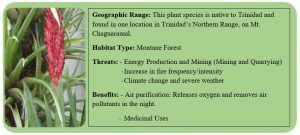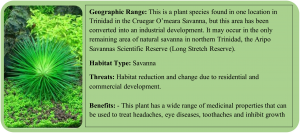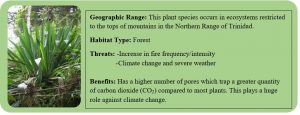
FIVE (5) CRITICALLY ENDANGERED SPECIES IN T&T.
What can we do to conserve them?
The term wildlife pertains to both animal species and plant species, i.e., flora and fauna, as well as their habitats. Our country, Trinidad and Tobago is one of the richest places in the world for flora and fauna and is a host to over 3000 species and counting (El Socorro Centre for Wildlife Conservation, n.d.). While it may seem as though these species serve no purpose to our daily lives, there are numerous benefits to having a thriving wildlife population. These benefits include providing an avenue for natural medicines; safeguarding against climate change; improving soil health; enhancing cultural activities; and maintaining a balance in ecosystems.
Notwithstanding, the reality is that the wildlife population is undergoing a steep decline rate because of human activities such as mining, farming, and construction, and destruction of natural habitats. We exacerbate this situation by cutting down too many trees, clearing too much ground and consuming various types of food that compete with the natural environment. This situation has become a global issue as it puts species at risk and therefore, they become endangered.
March 3rd, 2022, marks the event called World Wildlife Day where we seek to raise awareness on this matter. The theme this year is “Recovering key species for ecosystem restoration” and seeks to highlight the critically endangered species in our ecosystems, to generate and implement workable solutions to conserve them. The International Union for the Conservation of Nature (IUCN) Red List of Threatened Species has designated 8,400 species of flora and wild fauna as critically endangered and 30,000 more as endangered. This list was then further narrowed down from a global scale to include five (5) critically endangered species in Trinidad and Tobago. These are:
Aechmea Downsiana

Eriocaulon Caesium

Phytotriades Auratus (commonly known as the Golden Treefrog)

Neurolepis Virgata

Pipile Pipile (commonly know as the Trinidad Piping-guan)

What we can do
Currently, we are faced with many issues such as pollution, deforestation, illegal hunting activities, and environmental issues that threaten the existence of our wildlife population. We need to overcome these challenges and proceed with conservation actions as wildlife and their natural habitat are a priority to mankind and future generations.
Here is a summary of conservation actions that can be implemented:
- Species Management- Ensure that native species are allowed their own appropriate and protected areas to guarantee the survival of already endangered species. This will require proper research and monitoring processes; wildlife conservation centers should revise current procedures and formulate action recovery plans as well as systematic monitoring schemes. Wildlife conservationists can also invest resources and research capabilities into Artificial Propagation as a means of reintroduction of species.
- Education and Awareness- Non-profit organizations, as well as environmental conservationist groups such as Papa Bois Conservation, Turtle Village Trust, Manatee Conservation Trust, and Trinidad and Tobago Field Naturalists’ Club, should continue to educate the public on the importance of wildlife as well as host community group clean-up activities, raise donations, plant trees to restore habitats and continue to update environmental challenges as they arise.
- Revise laws and policies- Although there are laws and policies developed for this specific issue, it is important to continuously improve the framework to ensure there are no missing gaps. Reporting procedures should also be revised and shared with the public.
- Land and Water Management- Before human activity takes place, there should be an assessment of the area to ensure it is not a conservation site. This information should also be regularly updated in system databases.
Conclusion
Man’s impact on the environment has had and is continuing to have a negative impact on the natural wildlife i.e., flora and fauna. Actions are necessary to reverse this trend not only for ourselves today but for future generations and in fact the survival of the planet itself. While we may feel overwhelmed by the magnitude of the problem and its solution, we can individually and collectively make a difference, even with small steps. As we celebrate World Wildlife Day, let us pledge to make a difference by changing our actions and attitudes to the natural environment.
References
- World Wildlife Day. (n.d.). Retrieved February 23, 2022, from https://www.twinkl.co.uk/event/world-wildlife-day-2022
- Hunte, K. (2013). World Wildlife Day- Environmental Conservationists in T&T a Brief History | National Archives of Trinidad and Tobago. Retrieved from http://natt.gov.tt/new/node/230
- Butler, R. A. (2019, October 5). List of Critically Endangered species in Trinidad & Tobago. Retrieved from https://rainforests.mongabay.com/biodiversity/en/trinidad_&_tobago/CR.html
- McMahon, M. (2022, February 4). What is Wildlife Conservation? Retrieved from https://www.allthingsnature.org/what-is-wildlife-conservation.htm
- (n.d.). Retrieved from http://www.golatofski.de/Pflanzenreich/gattung/a/aechmea.html
- net. (n.d.). Pénélope siffleuse – Pipile pipile – Trinidad Piping Guan. Retrieved from https://www.oiseaux.net/birds/trinidad.piping.guan.html
- Godley, B. J. (2017). The golden tree frog, Phytotriades auratus, El Tucuche, Trinidad [Photograph]. Retrieved from https://www.researchgate.net/figure/The-golden-tree-frog-Phytotriades-auratus-El-Tucuche-Trinidad-photo-credit-Gillian_fig2_320756864
- Tropica Eriocaulon cinereum. (n.d.). Retrieved from https://www.swelluk.com/tropica-eriocaulon-cinereum
- Mike Oatham (University of the West Indies). (2017, September 13). Aechmea downsiana. Retrieved from https://www.iucnredlist.org/species/115947008/115968166
- Mike Oatham (University of the West Indies). (2017b, September 13). Eriocaulon caesium. Retrieved from https://www.iucnredlist.org/species/115947523/115968211
- The ICUN Red List of Threatened Species. (n.d.). Retrieved from https://www.iucnredlist.org/
